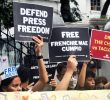A Dual-Book Review
Myfel Joseph D. Paluga
Department of Social Sciences
University of the Philippines Mindanao
Crisis Generates Resistance. By Jose Maria Sison. Volume 1 of People’s Struggles Against Oppression and Exploitation. The Netherlands: International Network for Philippine Studies (INPS), 2015. Editor: Julieta de Lima. 392 pp.
Building People’s Power. By Jose Maria Sison. Volume 2 of People’s Struggles Against Oppression and Exploitation. The Netherlands: International Network for Philippine Studies (INPS), 2016. Editor: Julieta de Lima. 474 pp.
Crisis Generates Resistance
Primary Source. For one with strong interest in the history of Philippine social movements, a quick browsing of this first two of a projected five volumes of Prof. Jose Maria Sison’s recent selected writings will directly give one an idea of its importance as a primary source in historiography. The book series is entitled People’s Struggles Against Oppression and Exploitation and is planned to cover his writings from 2010-2015. This is the third set of Prof. Sison’s series of selected writings. The first set to appear in print is a composed of five volumes, collecting his works from 1991-2009; while the second set of four collected his earlier writings from 1968- 1991.
It was a dawning surprise for me to realize that the total volumes of Sison’s selected works has already amounted to fourteen volumes, from 1968 to 2015 (although the last three volumes are yet to come out). The new generation of militants of the 21st century will learn both history and revolutionary social analysis from these selected works.
Writings in His ‘Age of Seniority’. I particularly enjoyed the first essays that I read in this present book which are tributes and eulogies to his compatriots and comrades because they contain priceless historical bits and human interests. Most of us do not really know human details of Sison’s life and so it is of interest that in this book’s personal sideglances of others’ well-lived lives we also get a peek into the biographic details of the man who, by his unceasing revolutionary works, must be recognized even this early as a giant in post-war Philippine social and political history. In an answer to a question on his take on the continuous state-sponsored ‘ad hominem attacks’ on his reputation, he said the following lines, with justified immodesty:
I have long retired from marching and sharing weal and woe with a platoon of the New People’s Army as often as I did from 1969 to 1977. But my forced exile does not make any puppet president or any of his subalterns more revolutionary than I am. (358)
When I die, I shall leave a legacy more cherished than that of all puppet presidents who are corrupt and brutal. For advocating national and social liberation, my writings will be studied seriously and will weigh more heavily than all the propaganda of the reactionary state and its hangers-on. (358)
Two Types of Political Writings. But I am drawn now into the spartan nature of the book cover (and of all the previous book covers of his selected writings; but I think the present book’s cover particularly stands out in its minimalism)—an unassuming font carrying a title-message, ‘crisis generates resistance,’ in a red-over-blue backdrop—as this, I think, reflects well the nature and character of Sison’s political writings.
There are political publications that seduce you—by words and images—to enter seriously, and with joy, its world-of-pages by its visual powers, literary strength, or even the so-called scholarly feel of its text, so that, if one has the readiness of heart and mind, one is then moved to act on things and matters at hand and, as they say, ‘join the movement.’ Seductive political writings move one by imagination and tries to carry you to the world of real struggles.
The political writings of Jose Maria Sison— at least from the sample of those that I have read—are, in my view, not of that type. They are organic in the life-story of Sison as a fulltime, all-round revolutionary and so are written mostly in the context of ‘arousing-organizing- mobilizing’ activities, solidarity expressions and other political labors in the international settings. In terms of style, perhaps Sison has cultivated a particular habit wherein he separates his ‘literary’ output from his ‘political’ Amado Guerero texts.
Formulaic or Durable Formula? One, especially an academic—a person used to writings that are soaked in a particular university culture of citations, footnotes, and all the socalled scholarly apparatus of textual presentations—might wonder why a work, like the classic Philippine Society and Revolution, which does not even have a bibliography, is held with high respect and is continually consulted by many activist scholars and non-scholars. The reason is that one should already be immersed in the social movement, in the history, debates, discourses in, as they say in academe’s, ‘the world of the real’—or one should, if not convinced, perhaps at least already be conversant in the grammar of the ‘national democratic movement’—in short, one should already be in the flow (and breaks) of political struggles to have the eye for the sharp and ever-usable formulations of Sison as he writes about and comments on varied sociopolitical themes in the national and global scene.
What looks like ‘formulaic statements’ to some—perhaps intellectuals whom Sison teases with a Maoist metaphor as ‘frogs in the well’—are, to those continuing the militant and revolutionary tradition, apt constructs to guide one in the day-to-day political struggles.
‘Foreclosing other forms of struggle’. Consider this one paragraph in a solidarity message given to Makabayan on the occasion of its founding assembly (16 April 2009):
The electoral form of struggle can be a major part ofthe movement to arouse, organize and mobilize the people to achieve basic reforms or the ultimate aim ofsocial revolution. There is no error ofelectoralism or parliamentarism when there is no foreclosing of other forms of struggle that the people have the sovereign right to adopt and wage. There is no error of reformism when there is no pontification that the struggle for reforms is the sole option of the people. (71)
Whether one finds the above paragraph ‘formulaic’ in the bad or in the good sense (appreciating its axiomatic and handy simplicity: ‘no error when there is no foreclosing of other forms of struggle’) depends on how immersed one is in the complexity of waging social transformative struggles in the whole continuum of political praxis.
‘Militarizing disasters’. Or read slowly the following excerpts from his statement in the wake of the magnitude-7 earthquake in Haiti (24 January 2010):
More than ever, the earthquake disaster in Haiti exposes the social vulnerability and devastation caused by two centuries of colonial slavery, debt bondage and modern imperialism. The capability of the people of Haiti to surmount the dire results of such a natural disaster has been undermined and debilitated by manmade disasters inflicted by foreign debt, US military interventions and occupation, and US-imposed “free market” policies. [….] Natural disasters have become one of the major pretexts for US military intervention and occupation in various parts of the world. It is the dastardly policy of the US government all over the world to militarize its every pretense at aid and relief assistance, to gain extraterritorial rights and to make propaganda for the acceptance of its military forces. (260, 261)
In highly compressed lines, one reads in the full message, where the above is excerpted, a tight weaving of information, which one can readily check elsewhere for sources, plus two well-crafted formulations given above: one, (the importance of highlighting economic disasters framing natural disasters) ‘the capability of people to surmount natural disasters are debilitated by manmade disasters inflected by a type of political economy’ and, two, (underlining the obscene militarization of disaster relief interventions) there is this US-initiated global trend of ‘militarizing every aid and relief assistance which ends up further entrenching neocolonial arrangements.’
So perhaps the book Crisis Generates Resistance should be better approached by people (students and faculty) in the academe by warning them early that—as in any nonliterary works of the poet, revolutionary, National Democratic Front political consultant Prof. Jose Ma. Sison— this is political writing not in the direction of the ‘seductive’ type but of the ‘formula-setting’ (or ‘formula-forging’) type. Perhaps there are prerequisites needed in order to appreciate and maximise the book’s value: one should read and read and read many peer-reviewed, scholarly works available elsewhere, both in the left and the right of the political spectrum, and one should extend and extend and extend oneself from the classroom to the different avenues of social engagements—and then go back to the political writings of Sison in order to, if not be convinced of his many parsimonious lines of analysis, be ready to engage intelligently with them.
One does not go to Sison’s writings to read the detailed facts or, to theory-excitable souls in the academe, to get sexy post-concepts. For book readers with ‘ND’ sympathies or convictions, one usually reads writings by others either to check their emperics or to widen their grasp of dialectics in everyday philosophies. But once one has, for overdetermined reasons, come to a life-decision that, in the divide between ‘social reproduction’ and ‘social transformation,’ one has chosen the latter—deciding that it is just and proper for humans to live in a world beyond commodity-ruled desires—then, in the Philippine setting foremostly (but now also in the international settings, as in the network of International League of Peoples’ Struggle), one reads Sison to ‘steel the tensility’ of one’s options in ‘concrete situations’ by his set of handy formulations.
Hurried Reflections. And yet, thinking again, perhaps this divide in style in Jose Maria Sison, the poetic seductive side (in his literary productions) and the spartan-formula setting side (in his politico-organizational productions), powerful in his own generation, is precisely what militant advocates should now struggle not to replicate easily and instead invent a range of styles and character apt for the young generations of the present.
Editor’s note: The next part of this article will discuss Sison’s Building People’s Power.





![[ANALYSIS] A different drug war](https://davaotoday.com/wp-content/uploads/2024/09/1000019103-110x100.png)




